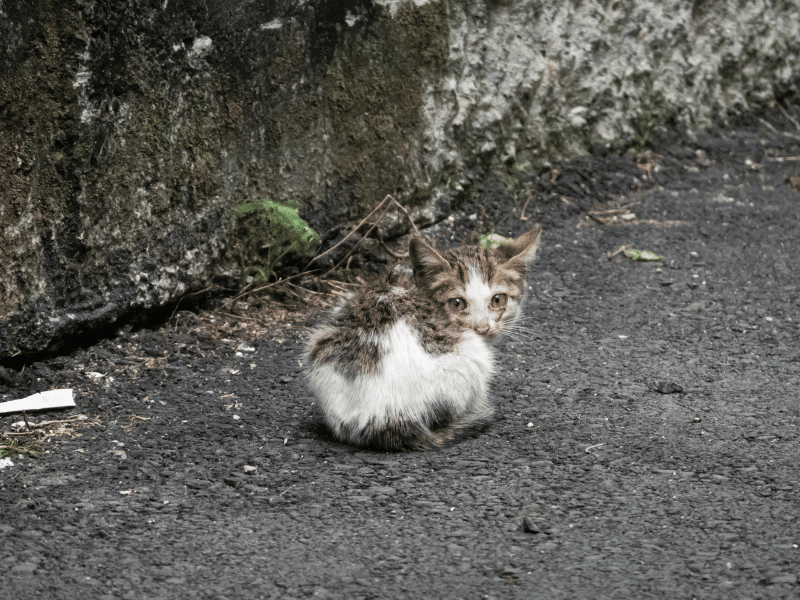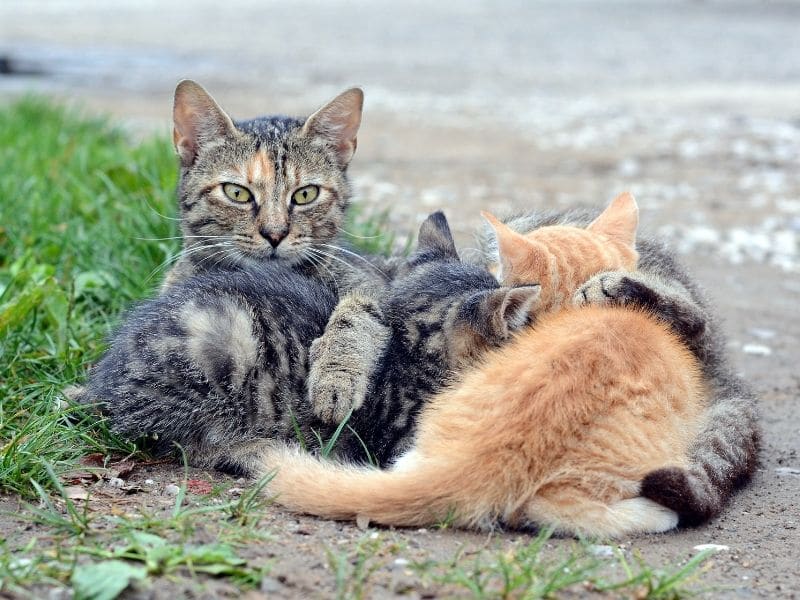From Spring until late Autumn, stray and feral unneutered female cats will usually be either pregnant or raising a litter of kittens.
During this time CLAWS is inundated with requests to assist feral cats and kittens, by the public, feeders and by Animal Welfare
We prioritize helping those who are sick or injured or in dangerous locations. Claws actively helps feeders of feral colonies, to try to neuter as many feral cats as possible, providing a safe place for the neutered animals to recover.
Pregnant mums: A pregnant mum is called a Queen. You can assume that almost any female stray cat which is does not have her ear “tipped” is likely to be pregnant.
Sometimes it will be obvious because she has a big belly and more prominent nipples
If you come across a female stray that you think may be pregnant, it is important to contact ANIMAL WELFARE or C.L.A.W.S. , so that arrangements can be made to trap her and give her a safe environment in which to have her kittens.
Good food in the few days between being found and giving birth can make all the difference to the health of the kittens when born.
Hiding Places : Mother cats usually hide their kittens very well and choose places such as in or under garden sheds, in dense undergrowth, and in or under discarded rubbish such as old furniture. They also like building sites, abandoned vehicles, or access cellars, loft spaces or empty buildings through small holes such as broken ventilation grills.
Do not disturb, contact ANIMAL WELFARE or C.L.A.W.S: If you discover a cat with a litter of kittens, it is best not to disturb them, as there is a risk that the mother cat will feel worried and decide to move her kittens to another hiding place.

How many kittens? : It is vital that we establish how many kittens there are in a litter to ensure that none are left behind. Feeding and observing the family for a few days will be required to find out how many kittens there are actually are.
Provide Food and OBSERVE : Provide mum with some food nearby to reassure her that you mean her and her babies no harm, and then contact ANIMAL WELFARE or CLAWS for advice and assistance.
We help all kinds of mums and kittens
Friendly mums: If the mother cat is friendly towards humans and her kittens are still very young, Animal Welfare should be able to collect them and move them to the safety of a foster home usually via an agency such as CLAWS.
Feral mums: If the mother cat is unfriendly towards humans, and either pregnant or with very young kittens, ANIMAL WELFAREshould still be able to trap them and move them, to the safety of a foster homer typically via an agency such as C.L.A.W.S. In this instance, we use an expert volunteer who have experience in dealing with angry mums!
Mobile Kittens: Sometimes pet kittens coming from a domestic home are just abandoned. These kittens will tend to be very approachable. More often they are the kittens of feral mums and if already mobile – walking and climbing around – then they may already be very nervous of actual human contact and will require safely capturing using specialist traps.
Domesticating rescued feral kittens : Once in CLAWS care, our dedicated volunteers spend time handling, playing with and socializing the kittens in order to tame and domesticate them. Most kittens can be domesticated with the right care.
How frequently do cats breed?
Cats are seasonal breeders, they generally give birth to two litters a year (but sometimes three) in Spring and mid – late Summer.
The cat mating season usually in January and February when unneutered female cats come in to season (“on heat”). They are soon mated by numerous unneutered male cats.
They are pregnant for 9 weeks.
A litter of kittens typically contains between 2 and 6 kittens.
Kittens are born with their eyes closed and initially reliant on their mother’s milk. Kittens’ eyes open at around 10 days old. They start to eat solid food between 4 and 6 weeks, but will also continue to be nourished with their mother’s milk during this time.
Mother cats frequently come back into season again and therefore can become pregnant again when their kittens are 6 weeks old, BUT some cats come back into season again within 2 weeks of giving birth.
Mother cats give birth to second litters in the summer, and some can give birth a third time in the same year.
Kittens themselves are capable of breeding from 4 months old.
You can see that it is CRUCIAL that we neuter mums as soon as we can and that all kittens that leave our care must be neutered within 6 months of birth if not sooner. This is part of our terms and conditions for adopting a cat from CLAWS.


